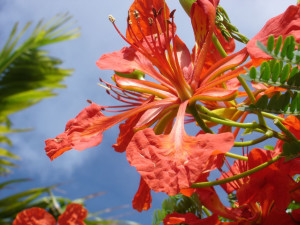Here in the Northern Hemisphere the days have been lengthening since December, and tomorrow comes the point where that age-old dance shifts steps: It is the longest day of the year tomorrow, June 21. The summer solstice occurs this year on Saturday morning at 6:51 here in Lake Worth, is Eastern Daylight Time (should you wish to calculate for your part of the world). We have reached the opposite side of where we were at Midwinter on the 21st of December. The sun reaches its northernmost point in the sky and then, after 6:51 AM, begins the journey south again.
It is our planet’s tilt that changes, not the sun. And in the process of our great blue globe’s shifting, the sun will appear, for a couple of days at least, to be still, and this is the source of our word solstice (from the Latin sol stetit, “sun stands still”). I like to ponder this immense globe that is our home and the mechanics of this constant shifting, but these are the thoughts that make my head hurt after a while. It is the pondering of immense things, and yet there are things so much more immense to ponder.
With the solstice, summer begins by the almanac. By traditional reckoning of time, however, summer has been with us since May Day, and this is why you will often hear this time of year referred to as Midsummer. And just as the birth of Christ was set at the winter solstice by the early Church, it was the birth of St. John that they placed at the opposite side, the summer solstice, and just as the world seems more magical at Christmastime, there are many mysteries surrounding the nights and days to come, especially St. John’s Eve on June 23rd. These junctions of time have long been considered times when it easier to cross between worlds seen and unseen. And whether these ideas are the stuff of folklore or of science (many astrophysicists suggest that the universe we know may be one of many parallel universes), if you are okay with an occasional willing suspension of disbelief, there is potential in these Midsummer nights for real beauty, real magic. It is the time to read Shakespeare’s comedy A Midsummer Night’s Dream. Or to watch the film version or, if you’re really lucky, to see it on stage. (An outdoor stage under the Midsummer stars? Even luckier.) It’s also a great time for a bonfire, which is traditional in many cultures for these Midsummer nights, whether it be solstice night or St. John’s Eve. Here in Lake Worth, the Finnish-American Club west of town will be having a Midsummer bonfire on Saturday night.
Our ancestors knew these were important nights to mark and celebrate. Even if it’s just the lighting of a candle, you’ll have done something to honor the day and the spiral dance of time. The only thing that stays the same is change. Come St. John’s Day on Tuesday, sunlight will have been diminishing slightly for three days as our dance once more shifts toward the next solstice in December. For now, though, the gentle season of summer is ours.
Image: The Royal Poincianas, a sure sign of the Summer Solstice in Florida, are all abloom now in Lake Worth. If you’ve never seen a Royal Poinciana, they are deciduous trees that explode in red blossoms each June before their lacy leaves appear. Summer here is not subtle.

I love this post. It makes me want to go twirling around a midnight bonfire. Probably not such a good idea with my back and having to carry kindling and all, but in my mind…
The swirl of colors, air rich with the perfume of roses here in Oregon. Celebrations abound. Thanks for ariculting another thoughtful pause, a time to contemplate the wonders of our circling, tilting sphere and our place on this earth. Glorious summer!
Good piece and gorgeous photo.